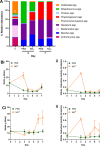Investigating the association between nitrate dosing and nitrite generation by the human oral microbiota in continuous culture
- PMID: 38440981
- PMCID: PMC11022587
- DOI: 10.1128/aem.02035-23
Investigating the association between nitrate dosing and nitrite generation by the human oral microbiota in continuous culture
Abstract
The generation of nitrite by the oral microbiota is believed to contribute to healthy cardiovascular function, with oral nitrate reduction to nitrite associated with systemic blood pressure regulation. There is the potential to manipulate the composition or activities of the oral microbiota to a higher nitrate-reducing state through nitrate supplementation. The current study examined microbial community composition and enzymatic responses to nitrate supplementation in sessile oral microbiota grown in continuous culture. Nitrate reductase (NaR) activity and nitrite concentrations were not significantly different to tongue-derived inocula in model biofilms. These were generally dominated by Streptococcus spp., initially, and a single nitrate supplementation resulted in the increased relative abundance of the nitrate-reducing genera Veillonella, Neisseria, and Proteus spp. Nitrite concentrations increased concomitantly and continued to increase throughout oral microbiota development. Continuous nitrate supplementation, over a 7-day period, was similarly associated with an elevated abundance of nitrate-reducing taxa and increased nitrite concentration in the perfusate. In experiments in which the models were established in continuous low or high nitrate environments, there was an initial elevation in nitrate reductase, and nitrite concentrations reached a relatively constant concentration over time similar to the acute nitrate challenge with a similar expansion of Veillonella and Neisseria. In summary, we have investigated nitrate metabolism in continuous culture oral biofilms, showing that nitrate addition increases nitrate reductase activity and nitrite concentrations in oral microbiota with the expansion of putatively NaR-producing taxa.IMPORTANCEClinical evidence suggests that blood pressure regulation can be promoted by nitrite generated through the reduction of supplemental dietary nitrate by the oral microbiota. We have utilized oral microbiota models to investigate the mechanisms responsible, demonstrating that nitrate addition increases nitrate reductase activity and nitrite concentrations in oral microbiota with the expansion of nitrate-reducing taxa.
Keywords: blood pressure; dietary nitrate; hypertension; multiple Sorbarod device; nitric oxide; nitrite; oral microbiota.
Conflict of interest statement
The authors declare no conflict of interest.
Figures






Similar articles
-
Salivary nitrite production is elevated in individuals with a higher abundance of oral nitrate-reducing bacteria.Free Radic Biol Med. 2018 May 20;120:80-88. doi: 10.1016/j.freeradbiomed.2018.03.023. Epub 2018 Mar 14. Free Radic Biol Med. 2018. PMID: 29550328
-
Sex differences in the nitrate-nitrite-NO• pathway: Role of oral nitrate-reducing bacteria.Free Radic Biol Med. 2018 Oct;126:113-121. doi: 10.1016/j.freeradbiomed.2018.07.010. Epub 2018 Jul 20. Free Radic Biol Med. 2018. PMID: 30031863 Clinical Trial.
-
Altered Oral Nitrate Reduction and Bacterial Profiles in Hypertensive Women Predict Blood Pressure Lowering Following Acute Dietary Nitrate Supplementation.Hypertension. 2023 Nov;80(11):2397-2406. doi: 10.1161/HYPERTENSIONAHA.123.21263. Epub 2023 Sep 13. Hypertension. 2023. PMID: 37702047
-
Current clinical framework on nitric oxide role in periodontal disease and blood pressure.Clin Oral Investig. 2024 Sep 12;28(10):521. doi: 10.1007/s00784-024-05913-x. Clin Oral Investig. 2024. PMID: 39264471 Free PMC article. Review.
-
Enterosalivary nitrate metabolism and the microbiome: Intersection of microbial metabolism, nitric oxide and diet in cardiac and pulmonary vascular health.Free Radic Biol Med. 2017 Apr;105:48-67. doi: 10.1016/j.freeradbiomed.2016.12.015. Epub 2016 Dec 16. Free Radic Biol Med. 2017. PMID: 27989792 Free PMC article. Review.
Cited by
-
The Western Diet and Atopic Dermatitis: The Potential Role of Nutrients, Contaminants, and Additives in Dysbiosis and Epithelial Barrier Dysfunction.Antioxidants (Basel). 2025 Mar 25;14(4):386. doi: 10.3390/antiox14040386. Antioxidants (Basel). 2025. PMID: 40298689 Free PMC article. Review.
-
Oral and gut microbiota in gingivitis subtypes: a causal inference study using Mendelian randomization.BMC Oral Health. 2025 Jul 28;25(1):1270. doi: 10.1186/s12903-025-06658-z. BMC Oral Health. 2025. PMID: 40722147 Free PMC article.
-
Acute exposure to groundwater contaminants mixture of nitrate, atrazine and imidacloprid impacts growth kinetics of poultry cecal microbiomes and significantly decreases Caco-2 cell viability.bioRxiv [Preprint]. 2025 Jun 20:2025.06.15.659797. doi: 10.1101/2025.06.15.659797. bioRxiv. 2025. PMID: 40666978 Free PMC article. Preprint.
-
New advances in oral microbiology and tumor research.World J Clin Oncol. 2025 Jul 24;16(7):106981. doi: 10.5306/wjco.v16.i7.106981. World J Clin Oncol. 2025. PMID: 40741186 Free PMC article. Review.
References
-
- NICE . 2011. Hypertension: the clinical management of primary hypertension in adults. National Institute of Clinical Excellence, National Clinical Guideline Centre, London (UK).
Publication types
MeSH terms
Substances
Grants and funding
LinkOut - more resources
Full Text Sources
Miscellaneous

